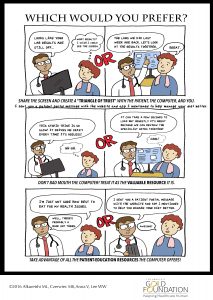by Lolita Alkureishi, MD, FAAP and Wei Wei Lee, MD, MPH
Lolita Alkureishi, MD, FAAP, is an Assistant Professor in General Academic Pediatrics and Wei Wei Lee, MD, MPH, is an Assistant Professor in General Internal Medicine at the University of Chicago. Together with their colleague Dr. Vineet Arora, they have developed curricula around patient-centered technology use to enhance communication and conducted qualitative research to better understand how patients view clinicians’ use of technology. They have created workshops to train medical students, interns, residents and attending physicians on patient-centered EHR skills and have received funding from the Gold Foundation and Picker Institute to further this work.
In 2010, our outpatient internal medicine and pediatric practices adopted an electronic health record (EHR). We struggled to manage the demands of the EHR while maintaining our focus on our patients. We soon recognized that we weren’t the only physicians to have to manage this change.
EHRs have gotten a bad rap. Physicians often cite the EHR as negatively contributing to their workload and stress. But we knew that the EHR was here to stay and that we had to find ways to leverage the EHR’s potential to stimulate discussion, augment patient education, and facilitate shared decision making.
Finding the best patient-centered practices
We discovered that few physicians are formally trained on best EHR use
As medical educators, we became interested in learning more about how the EHR impacts patient-doctor communication. We applied for and received a Mapping the Landscape, Journeying Together literature review grant from the Gold Foundation to examine the research that had been conducted on this topic. Our review was published in the Journal of General Internal Medicine and showed that though best practices existed for patient-centered EHR use, few physicians, residents or students were formally trained on how to use the EHR to engage patients and enhance patient-doctor communication.
In order to fill this gap in training, we applied for and received a Picker Gold Graduate Medical Education Challenge Grant to develop curricula for students, residents and faculty on patient-centered EHR use. We also interviewed patients about their perceptions of provider EHR use and incorporated their input into our curriculum to truly make it patient-centered.
By 2013, we successfully implemented a required curriculum on patient-centered EHR use, targeting all second-year medical students at the Pritzker School of Medicine at the University of Chicago. The 90-minute curriculum reviewed the pitfalls physicians often face in using EHRs, as well as a mnemonic (HUMAN LEVEL) we developed highlighting best practices (included in free downloadable curriculum). “HUMAN LEVEL” includes items such as “Honoring the Golden Minute” by making the start of the visit technology free, and “Using the Triangle of Trust” to ensure that both the physician and patient can both see the computer.
Reaching those elusive residents
Good habits established in these critical early years can last a lifetime
As a next step, we struggled with how to train residents on patient-centered EHR use. Unlike medical students who sit in lectures for hours, residents are an elusive group to target due to duty-hour restrictions and complex shift-work schedules. Regardless, we knew that training them was an absolute necessity. Residents are on the front line in patient care and have a tremendous amount of contact with patients in both hospital and clinic settings. Forming good habits as a resident can last a lifetime, so we met the challenge with creativity.
We knew that EVERY SINGLE new intern, resident and fellow in EVERY SPECIALTY at the University of Chicago was REQUIRED to take 4 hours of EHR training. So we formed a partnership with our EPIC© EHR trainers and found our captive audience at last! By partnering with our EHR team, we were able to add value to the existing training. We could now teach trainees how to use the EHR with patients to promote humanism and improve patient-doctor communication. Starting in 2015, we integrated a 15-minute patient-centered EHR training (a very distilled version of our more lengthy student curriculum) into the existing EHR training and introduced best practices and pitfalls. The main takeaway was that engaging and educating patients in their care is a reflection of a physician’s professionalism and an essential part of their professional development.
We had nearly 160 trainees complete training in the first year, with representation from primary care as well as from trainees in 27 specialties. Survey results were overwhelmingly positive, noting improved measures like significant increases in their knowledge of barriers to and best practices for patient-centered EHR use. More importantly, residents reported that they thought the training would change their future practice.
Now to the C-suite
Will healthcare leaders be intrigued by these findings, too?
 In 2016, we traveled to EPIC© headquarters in Madison, Wisconsin, to present our findings at their annual Users Group Meeting (UGM) in front of their Physician’s Advisory Council. Unsure of how our innovation in communication skills training would be received in such a venue, we were stunned to see over 200 people in attendance. Not a single seat was free. It was standing room only! Our presentation was one of the highest rated at the meeting, and we were invited to return in 2017 to deliver our talk as a “UGM Classics’ Talk.” Members of the C-Suite from healthcare organizations across the country commented on how it was the most thoughtful, practical presentation of researched best practices they had seen. We have since begun a rich dialogue with some of them on how to partner to bring this training to their institutions.
In 2016, we traveled to EPIC© headquarters in Madison, Wisconsin, to present our findings at their annual Users Group Meeting (UGM) in front of their Physician’s Advisory Council. Unsure of how our innovation in communication skills training would be received in such a venue, we were stunned to see over 200 people in attendance. Not a single seat was free. It was standing room only! Our presentation was one of the highest rated at the meeting, and we were invited to return in 2017 to deliver our talk as a “UGM Classics’ Talk.” Members of the C-Suite from healthcare organizations across the country commented on how it was the most thoughtful, practical presentation of researched best practices they had seen. We have since begun a rich dialogue with some of them on how to partner to bring this training to their institutions.
We’ll now be traveling back to EPIC© in April to present at their Experts Group Meeting on an objective and validated tool we developed to assess a provider’s patient-centered EHR use. The tool is the first of its kind, and we hope it helps facilitate specific and structured feedback to trainees and practicing physicians alike on how to improve their patient-centered EHR use.
So, while capturing residents may be a difficult task, finding creative opportunities to reach them was the key. Patient-centered EHR training is now an official part of the onboarding process for new trainees at the University of Chicago, and we are looking to embed it into all EPIC training for staff and practicing providers as well.
Through a Mapping the Landscape Advocacy grant, we are making this training and our tools more accessible to clinics and hospitals around the country. We have developed a video highlighting best practices for using the EHR and a video about patient experiences with the EHR, both of which are freely available online. In addition, we have developed both a patient comic and a provider comic to be used as conversations starters around issues of EHR use in our internal medicine and pediatrics clinics.
We are excited to continue our work in promoting positive EHR use that respects and benefits our patients and creates an institution-wide shared model of professionalism and high-quality patient care in the digital era.
Resources:
- Video: Improving Patient-Centered Computer Use in Clinical Care
- Video: How’s Your Computer-Side Manner? Patient Perspectives on the Patient-Doctor-Computer Interaction
- Handout: Patient Comic about EHR Use
- Handout: Provider Comic about EHR Use
- MedEd Portal Curriculum (free download of materials including the HUMAN LEVEL mnemonic): Breaking Away from the iPatient to Care for the Real Patient: Implementing a Patient-Centered EMR Use Curriculum
- Journal Article (free full text): Impact of Electronic Medical Record Use on the Patient–Doctor Relationship and Communication: A Systematic Review
- Journal Article (free full text): Patient Perceptions of Electronic Medical Record Use by Faculty and Resident Physicians: A Mixed Methods Study
- Journal Article (free full text): Integrating Patient-Centered Electronic Health Record Communication Training into Resident Onboarding: Curriculum Development and Post-Implementation Survey Among Housestaff
- Journal Article: Electronic-Clinical Evaluation Exercise (e-CEX): A new Patient-Centered EHR Use Tool


